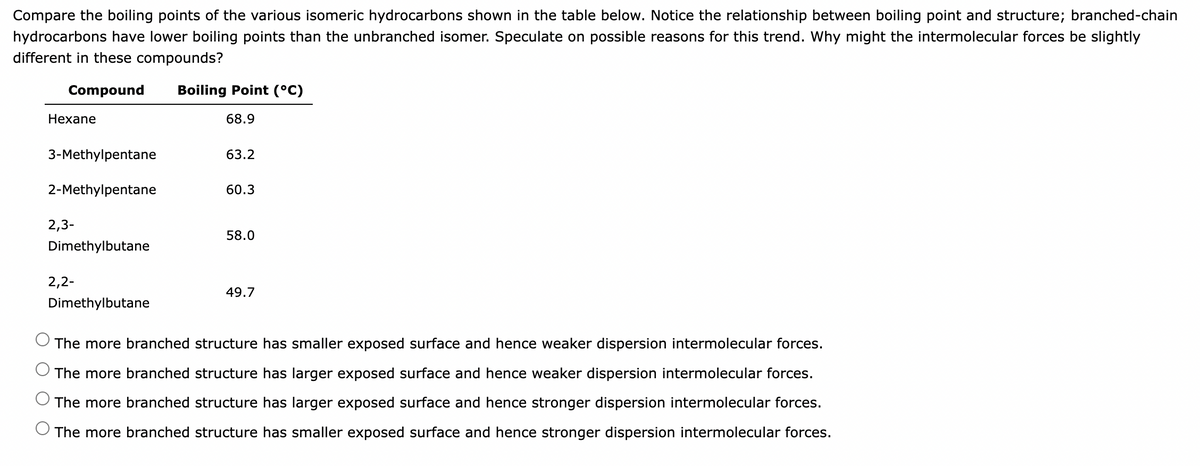Compare the boiling points of the various isomeric hydrocarbons shown in the table below. Notice the relationship between boiling point and structure; branched-chain hydrocarbons have lower boiling points than the unbranched isomer. Speculate on possible reasons for this trend. Why might the intermolecular forces be slightly different in these compounds? Compound Boiling Point (°C) 68.9 Hexane 3-Methylpentane 2-Methylpentane 2,3- Dimethylbutane 2,2- 63.2 60.3 58.0 49.7 Dimethylbutane O The more branched structure has smaller exposed surface and hence weaker dispersion intermolecular forces. O The more branched structure has larger exposed surface and hence weaker dispersion intermolecular forces. O The more branched structure has larger exposed surface and hence stronger dispersion intermolecular forces. O The more branched structure has smaller exposed surface and hence stronger dispersion intermolecular forces.
Compare the boiling points of the various isomeric hydrocarbons shown in the table below. Notice the relationship between boiling point and structure; branched-chain hydrocarbons have lower boiling points than the unbranched isomer. Speculate on possible reasons for this trend. Why might the intermolecular forces be slightly different in these compounds? Compound Boiling Point (°C) 68.9 Hexane 3-Methylpentane 2-Methylpentane 2,3- Dimethylbutane 2,2- 63.2 60.3 58.0 49.7 Dimethylbutane O The more branched structure has smaller exposed surface and hence weaker dispersion intermolecular forces. O The more branched structure has larger exposed surface and hence weaker dispersion intermolecular forces. O The more branched structure has larger exposed surface and hence stronger dispersion intermolecular forces. O The more branched structure has smaller exposed surface and hence stronger dispersion intermolecular forces.
Chemistry & Chemical Reactivity
9th Edition
ISBN:9781133949640
Author:John C. Kotz, Paul M. Treichel, John Townsend, David Treichel
Publisher:John C. Kotz, Paul M. Treichel, John Townsend, David Treichel
Chapter11: Intermolecular Forces And Liquids
Section: Chapter Questions
Problem 59SCQ
Related questions
Question

Transcribed Image Text:Compare the boiling points of the various isomeric hydrocarbons shown in the table below. Notice the relationship between boiling point and structure; branched-chain
hydrocarbons have lower boiling points than the unbranched isomer. Speculate on possible reasons for this trend. Why might the intermolecular forces be slightly
different in these compounds?
Compound Boiling Point (°C)
68.9
Hexane
3-Methylpentane
2-Methylpentane
2,3-
Dimethylbutane
2,2-
Dimethylbutane
63.2
60.3
58.0
49.7
The more branched structure has smaller exposed surface and hence weaker dispersion intermolecular forces.
The more branched structure has larger exposed surface and hence weaker dispersion intermolecular forces.
The more branched structure has larger exposed surface and hence stronger dispersion intermolecular forces.
The more branched structure has smaller exposed surface and hence stronger dispersion intermolecular forces.
Expert Solution
This question has been solved!
Explore an expertly crafted, step-by-step solution for a thorough understanding of key concepts.
This is a popular solution!
Trending now
This is a popular solution!
Step by step
Solved in 2 steps

Knowledge Booster
Learn more about
Need a deep-dive on the concept behind this application? Look no further. Learn more about this topic, chemistry and related others by exploring similar questions and additional content below.Recommended textbooks for you

Chemistry & Chemical Reactivity
Chemistry
ISBN:
9781133949640
Author:
John C. Kotz, Paul M. Treichel, John Townsend, David Treichel
Publisher:
Cengage Learning

Chemistry & Chemical Reactivity
Chemistry
ISBN:
9781337399074
Author:
John C. Kotz, Paul M. Treichel, John Townsend, David Treichel
Publisher:
Cengage Learning

Chemistry: Principles and Reactions
Chemistry
ISBN:
9781305079373
Author:
William L. Masterton, Cecile N. Hurley
Publisher:
Cengage Learning

Chemistry & Chemical Reactivity
Chemistry
ISBN:
9781133949640
Author:
John C. Kotz, Paul M. Treichel, John Townsend, David Treichel
Publisher:
Cengage Learning

Chemistry & Chemical Reactivity
Chemistry
ISBN:
9781337399074
Author:
John C. Kotz, Paul M. Treichel, John Townsend, David Treichel
Publisher:
Cengage Learning

Chemistry: Principles and Reactions
Chemistry
ISBN:
9781305079373
Author:
William L. Masterton, Cecile N. Hurley
Publisher:
Cengage Learning

Chemistry: An Atoms First Approach
Chemistry
ISBN:
9781305079243
Author:
Steven S. Zumdahl, Susan A. Zumdahl
Publisher:
Cengage Learning